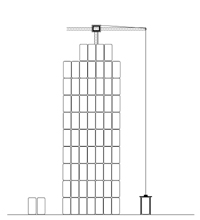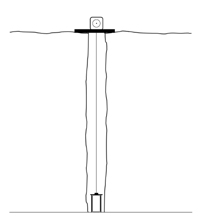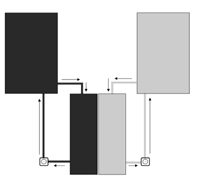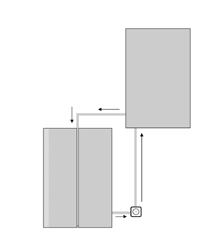Back to Fort Fairfield Journal WFFJ-TV Contact Us
Part III
Power Storage
By: David Deschesne &
Paul Philbrick
Since the sun doesn’t always shine and the wind doesn’t always blow, we need to have extra capacity in solar PV panels and/or wind turbines in order to store the energy so the grid power can be maintained at a constant level.
Ordinarily, the grid is supplied with electricity from reliable and consistent fossil-fuel (or nuclear, where available) power plants and are merely augmented with wind or solar. But, with the political impetus to switch everything over to “green” energy and eliminate fossil fuel power plants, an efficient method of storage of excess energy must be planned for.
There are a variety of ways to store energy for use when the sun or wind is not providing for us. Some are better than others, but none are at full grid level yet if the benchmark is to go all green energy. Below are a few energy storage options that are being developed, how they work and what their shortcomings are.
Pumped Water

A pumped water system is essentially a hydroelectric dam but rather than the filling the reservoir with a river or streams, the water is pumped uphill to above the dam, released and dropped through a turbine and collected in a basin at the bottom of the dam to be pumped back to the top over and over again. This method is nearly as reliable as conventional hydroelectric, but it would be difficult to expand to provide grid-level storage because most of the areas that are able to provide the infrastructure for a flood plain and water collection basin are already being used for conventional hydro power. The land acquisition and permitting process to create a large scale pumped water storage system would be in most cases cost prohibitive and would surely meet with opposition from staunch environmentalists.
Compressed Air

As the name implies, the compressed air energy storage system is simple in concept. The excess electricity from solar panels is used to run an air compressor which stores the energy as compressed air, then releases it through a turbine to generate electricity as needed.
Both in theory, and in the workshop, one can store pressurized air in a closed vessel, and control the pressurized air released out of the storage vessel, directing it through an air turbine of some sort, thereby producing enough power to light about quantity (1), 100 watt, incandescent lamp. But, there is no known air turbine, compressor, and closed vessel of sufficient efficiency that is being developed to produce electricity on a commercial scale.
Of course there is that nagging problem with compressed air energy storage: it takes electrical energy to compress air, and therein lies the crux of the problem. Too much required energy input, for a pittance of energy output. This type of energy storage is actually worse than batteries.
Gravity Based
There are two types of gravity based systems being developed. One uses excess energy to lift large blocks of concrete into the air, stack them and store the energy in that way. See this diagram:

Another gravity-based system works in the same way, but uses a single weight in an abandoned mine shaft, or purpose-built mine shaft like this diagram shows:

Neither of the gravity-based systems have been successfully built and placed into operation at a grid-level scale. Developers brag about efficiency ratings and cost per kilowatt hour better than batteries, but none of those claims have actually been objectively proven as of this date.
- BATTERIES -
This now leads us to batteries, of which there are several concepts—some old and some new. Here are the main options so far:
Lead Acid

By far the most common type of battery, used in nearly all motor vehicles for starting and a “marine” version for deep cycle use in boats. The marine lead-acid batteries are used to store energy in small home solar panel setups due to their relatively low cost and ease of acquisition. These batteries are the least efficient energy storage, but do provide an entry level option for those on a budget. The life span of a typical marine type lead-acid battery is five years. Due to the weight and low power efficiency, lead-acid batteries are not ideal for uses like electric vehicles where size and weight are primary considerations. A typical marine battery costs around $100.
Lithium Iron Phosphate
LIP batteries are the next generation battery up from the lead-acid. The style used in solar and wind storage for home and business use are roughly the same size as a marine battery, but are much lighter, have a higher power density and longer lifetime. These types of batteries are being used in larger home off-grid systems and backup power. LIP batteries are considerably more expensive than conventional lead-acid, starting at around $900 - $1,000. Tesla is currently developing a version of LIP for use in their electric vehicle battery systems to replace the older technology Lithium Ion batteries. LIP batteries are less subject to thermal runaway and catching fire, and can be charged faster than other batteries but they don’t do as well in the cold so they do need to be maintained at around room temperature for maximum efficiency. This rules them out in electric vehicles in colder climates where the battery’s energy in a vehicle would be siphoned off for heating the battery and passenger compartment of the vehicle, thus drastically reducing range between charges. Lithium is available in abundance, mostly in South America, as a salt dissolved in huge underground lakes. However, it is estimated that there is only half the amount in existence that would be necessary to provide grid-scale backup batteries with this metal for a global alternate energy power grid.
LIP batteries are currently difficult to recycle and cost more per pound to reclaim the lithium than it does to simply mine it from the earth.
Liquid Metal Batteries

As the name implies, LM batteries use various minerals and metals in a molten, liquid state to store electricity. Looking at the diagram, above, think of how the liquids: honey, water and oil would settle and stratify in a container. In LM batteries, the same thing occurs but with metals at much higher temperatures. The most common metals in LM batteries are composed of Antimony and Magnesium as cathode and electrode, respectively. The two metals are separated by a dielectric composed of sodium. While LM batteries are more robust than lithium based batteries, can be discharged much deeper and last up to 20 years, one of the major setbacks is they have to maintain an operating temperature of around 450º F. They are shipped at room temperature so the metals are in a safe, solid state and once installed they have to be heated by an external energy source to melt the metals. Once up to temperature, the charging and discharging cycles may create enough heat to keep them in their liquid state. Since the battery is in liquid form, it cannot be used in applications like electric vehicles where the liquid metals would be jostled around and short-circuit each other.
LM batteries aren’t as power dense as lithium batteries and can only be really used for grid-level storage. The technology is still being developed.
Flow Batteries
Flow batteries use a liquid anode and cathode that is circulated with pumps at room temperature. Energy is stored during charging by oxidizing one liquid while reducing the other. Energy capacity is purely a function of the tank size in the closed system. One of the electrolytes used in Flow batteries is Vanadium, which is more abundant than nickel or even lithium but it is much less abundant than aluminum and iron

Some experimental flow batteries are composed of organic electrolytes and one style is even being developed that uses a single tank of solution composed of iron particles, salt and water—which would be the easiest to procure.

To scale up to grid level capacity would require a huge amount of fossil fuel based mining, refining and manufacturing to create these complex systems. Also, due to their complexity they are infinitely more labor intensive to maintain and keep operating. Because they are composed of liquid, Flow batteries would not be able to operate efficiently in climates that are below zero for long periods of time.
The bottom line is regardless of the battery technology, fossil fuels will never be eliminated on the timelines proposed by the greenies because their energy density is what it required to acquire the raw materials to build the esoteric battery systems to begin with.
Bibliography:
https://www.youtube.com/watch?v=JoCDKSmJOag
https://www.youtube.com/watch?v=zX1ukoE3Cw4
https://www.youtube.com/watch?v=lGPlrzk5iDE
https://www.youtube.com/watch?v=lGPlrzk5iDE
https://www.youtube.com/watch?v=J_jaNokNWVA
https://www.youtube.com/watch?v=JxGP9cYbwdk
https://www.youtube.com/watch?v=YyzQsVzKylE
https://www.youtube.com/watch?v=m8751tkBU_Q

